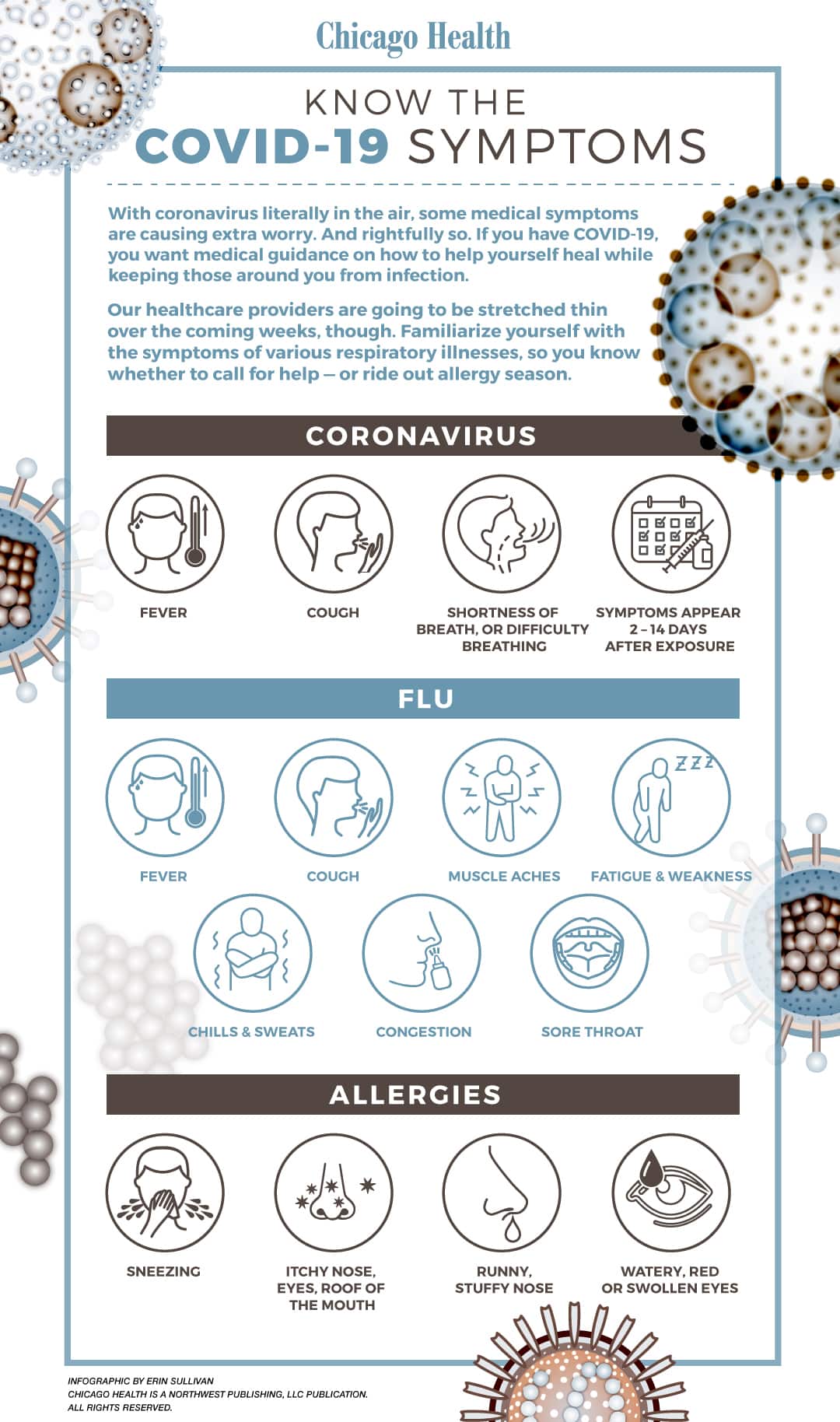With its symptoms of high fever, cough and body aches — and its potential to be severe — the coronavirus has drawn comparisons to the flu. However, make no mistake: The new coronavirus is no flu.
Even though both are spread through respiratory droplets, the coronavirus is affecting people with far more severity and rapidity than the flu. The coronavirus is also shaping up to be much more deadly than the flu, especially among the elderly and those with underlying health conditions.
Because COVID-19, the flu and the common cold can start with somewhat similar symptoms, many individuals worry that their symptoms mean they have coronavirus.
Here’s what you need to know about differences between the coronavirus, the flu and a cold, as well as what to do if you think you have COVID-19 symptoms.
More serious than the flu
Because COVID-19, or SARS-CoV-2, is a new virus, the population has poor immunity to it, which helps it spread faster, says Maximo Brito, MD, MPH, an infectious disease specialist and professor of medicine at the University of Illinois College of Medicine.
There are many unknowns about COVID-19 and how it will affect those in the U.S., echoes Kevin Smith, MD, chief medical officer of Loyola University Medical Center. Because the virus has never been seen before, experts need to make projections based on early findings, he adds.
“There are still some things we don’t know, including how many people this virus will ultimately infect and if we are going to be able to keep up with the number of patients,” Smith says.
Because of a shortage of testing, numbers of those infected in the U.S. are not clear. If you consider the estimated number of people who may be infected with the coronavirus and not yet diagnosed, the disease is at least 10 times more lethal than the flu, says Anthony Fauci, MD, director of the National Institute of Allergy and Infectious Diseases.
The New York Times reported internal CDC estimates that between 160 million and 214 million Americans could contract the coronavirus over the course of the epidemic and 200,000 to 1.7 million people in the U.S. could die from it, depending on different scenarios of how it will spread. By comparison, the flu causes 12,000 to 61,000 deaths a year in the U.S., according to the CDC.
And unlike the flu, COVID-19 is full of questions.
“Seasonal flu is more or less predictable at this point. Provided it’s not a pandemic influenza, we can estimate approximately how many people are going to get the seasonal flu every year, and we can estimate how many of those people will die from it. So we kind of know that enemy,” Brito says. “We don’t know coronavirus.”
Because the coronavirus is a novel virus, it can have a different trajectory from the flu, he says. “We shouldn’t assume that everything we know about the flu is everything that’s going to occur with the coronavirus,” he says. “We can estimate from what happened in China and what’s happening in Italy, but those are very different populations and those are very different societies” than the United States.
Know the symptoms of COVID-19
With everyone on edge about COVID-19, many patients are asking whether they have the virus, Smith says. The hallmark symptoms of COVID-19 are distinct, but some of the milder symptoms may be more subtle.
“The symptoms of COVID-19 are fever, dry cough and shortness of breath. However, fever is not always present,” he says. “Some people also have reported diarrhea and muscle aches.”
In contrast, patients with colds or allergies won’t have a fever and typically won’t have shortness of breath, he says.
For about 80% of people with COVID-19, symptoms will be mild, according to figures from China.
“For the majority of people, COVID-19 causes mild symptoms, and many people may even have no symptoms at all,” Smith says. “It is sometimes difficult to determine whether someone has COVID-19 based solely on their symptoms.”
Indeed, individuals who are asymptomatic or have mild symptoms may be drivers in spreading the disease. Younger people tend to have more mild symptoms of COVID-19, but they can still carry the disease and transmit it to others.
“If children have any signs of a cold or sniffles, it’s a good idea to keep them away from the older individuals in their lives so they can prevent infection of those individuals,” Brito says, adding that the caution applies to adults too, not just children. “Be mindful that [people] can have a milder disease, but they can act as multipliers of the disease to older adults.”
Brito adds, “Coronavirus seems to be on a spectrum of disease. So a lot of people, especially children, develop a very mild disease, which can be confused with a common cold. Whereas people who are older can develop a very severe illness, which can be fatal.”
When and how to seek medical attention
If you are concerned that you may have the coronavirus — especially if you develop a fever along with a cough or difficulty breathing — call your healthcare provider. Your physician’s office will likely put you in touch with a COVID-19 hotline.
If your symptoms are mild, it’s important not to go to the emergency room, because hospitals need the space and the staff to treat people who are severely ill with COVID-19. You also don’t want to risk spreading the virus to others if you do have it. Call your healthcare provider first if you plan to go into the office.
Although you may want a definitive answer as to whether you have COVID-19, you might not be able to be tested because of a shortage of tests. In that case, a physician or nurse might instruct you to recover at home and to isolate yourself to prevent the spread of the virus.
“Know that the vast majority of people with symptoms have mild symptoms. If this is the case, you are going to recover on your own,” Smith says. “However, you should self-quarantine in your home for 14 days.” That means not going out and staying in a different part of your home — and using a different bathroom, if possible — from people who live with you.
It can be hard to live with the unknowns, though, especially when stress related to the coronavirus and to self-isolation abounds. The lack of testing puts a lot of people in limbo, unsure of how much to separate themselves from others.
“I’m sure everyone wants to know, ‘Is what I’m having coronavirus?’” Brito says. “But given what’s going on in terms of scarcity of tests, staying home and preventing the spread of disease is more important than knowing that you have the coronavirus, as long as you self-isolate. if you’re not short of breath, the best thing to do is to stay at home if you’re experiencing symptoms and you’re not too sick.”
While self-isolation and physical distancing is hard, it’s vital for the health of others.
“You should think about yourself as a member of the community and not as an individual.” Brito says. “We need everybody to think about community.”


Eve Becker is an award-winning editor and writer. She is the former Editor-in-Chief of Chicago Health magazine and Caregiving magazine, as well as the former Managing Editor of Tribune Media Services. She is a highly skilled communications professional, and has created content for a variety of platforms, including magazines, newspapers, websites, newsletters and nonprofit organizations.












